Vision 2025 - National Research Centre for Grapes
Vision 2025 - National Research Centre for Grapes
Vision 2025 - National Research Centre for Grapes
Create successful ePaper yourself
Turn your PDF publications into a flip-book with our unique Google optimized e-Paper software.
Fig. 9. Improved per<strong>for</strong>mance of grafted vines<br />
(Right) as compared to own rooted (Left)<br />
at reduced level of irrigation<br />
• In the variety Tas-A-Ganesh, retention of only 35<br />
shoots after back pruning and maintaining 40<br />
bunches per vine after <strong>for</strong>ward pruning was found to<br />
be optimum <strong>for</strong> obtaining significantly higher yield,<br />
berry weight and berry diameter. Similarly, clipping<br />
a flower cluster up to 35%, gave higher yield with<br />
quality bunch.<br />
• In Tas-A-Ganesh horizontal single cordon training<br />
modification recorded higher yield and lower disease<br />
incidence than double cordon system on flat roof<br />
gable system of training.<br />
• Tas-A-Ganesh vines grafted on Dogridge rootstock and trained with double stem on flat roof<br />
gable training system per<strong>for</strong>med better as compared to single stem under the same system<br />
of training.<br />
• Growth stage wise fertilizer application through drip (fertigation) in grafted Thompson<br />
seedless vines resulted in 60% savings in fertilizer use over the conventional method of soil<br />
application, thus improving fertilizer use efficiency and reducing salinity hazard and<br />
pollution of ground water.<br />
• An irrigation schedule based on pan evaporation and growth<br />
stages of grafted grape vines have been developed <strong>for</strong> optimal<br />
water use in grapes. The schedule improves the water use<br />
efficiency by almost 141 per cent.<br />
• Tas-A-Ganesh grafted on rootstock showed better water use<br />
efficiency compared to own rooted vines and resulted in the<br />
saving of 25% irrigation water.<br />
• Use of subsurface irrigation and mulch + Antistress resulted in<br />
improved water use efficiency and lead to saving of 25% of<br />
irrigation water on grafted vines.<br />
• Rootstock B2/56, resembling 110 R was found to have better salt exclusion as indicated by<br />
lower sodium content in petiole of Thompson Seedless vines grafted on this rootstock. The<br />
yield was also highest in vines grafted on this rootstock.<br />
• Black leaf disorder observed in many vineyards were attributed to<br />
low potassium content and / or excess sodium<br />
• The shiny spot symptoms and marginal necrosis of leaf blade were<br />
found to be due to potassium deficiency.<br />
Fig. 10. Subsurface irrigation<br />
• DRIS norms <strong>for</strong> the vineyards, based on petiole nutrient contents<br />
were developed. Among the different diagnostic parameters, P/N,<br />
Fig. 11. Black leaf disorder<br />
K/N, P/Zn had greater physiological rationale during flowering<br />
stage whereas N/P and N/K were critical during bud differentiation stage.<br />
• The stages and doses of the bioregulators (Uracil, 6-BA, GA 3 and CPPU) <strong>for</strong> improving<br />
bunch and berry quality have been standardized on Thompson seedless and Tas-A-Ganesh<br />
vines. Efficacy of gibberellic acid could be improved by using adjuvents like phosphoric<br />
acid and urea phosphate in acidic range.<br />
9





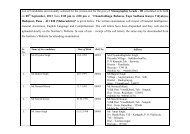
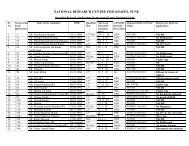

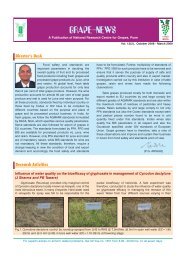

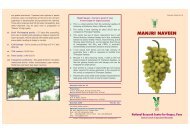
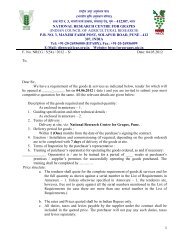



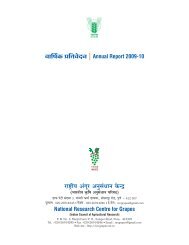
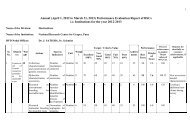
![mj]mJ{V cmcH$m{irM{ (_mBQâ¤>g) oZ`ÃÃU](https://img.yumpu.com/33367555/1/190x127/mjmjv-cmchmirm-mbqag-ozaau.jpg?quality=85)